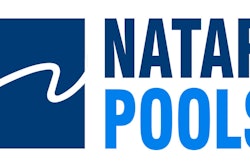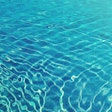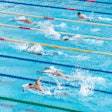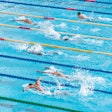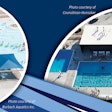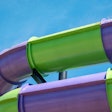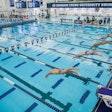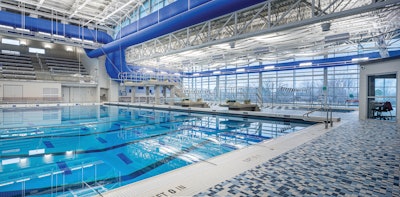
Misperceptions abound about indoor pools and outdoor pools. One of the biggest has to do with costs to build and operate.
“People think, ‘Oh, indoor pools aren’t that much more expensive than outdoor pools,” says Paul Stewart, vice president of sales, marketing and service at Desert Aire LLC, a supplier of commercial dehumidification systems. “Au contraire. They’re 10 to 15 times more expensive to build — and then you need to start talking about maintaining an indoor pool.”
While it’s true that both indoor and outdoor pools off-gas chloramines — chemicals such as dichloramine and trichloramine that form when chlorine binds with such human organics as urine and sweat — they scatter quickly in the air at outdoor facilities. Inside, it’s a different story.
Excessive chloramines in an indoor pool environment can lead to swimmer and spectator discomfort that includes such symptoms as itchy eyes, irritated skin and respiratory issues. What’s more, trichloramines — which can be up to three times heavier than air — “eat metal,” in the words of Mark Hines, vice president of sales and marketing for Paddock Pool Equipment Co., which manufactures an indoor air-quality system called the Evacuator®.
He references the collapse of indoor pool ductwork in May at the Gaylord Rockies Resort in Aurora, Colo., that injured several people, speculating as the culprit poor indoor air quality that deteriorated the metal over time. As of mid-summer, the incident appeared to still be under investigation.
“We’ve done a really good job explaining to architects what trichloramines are, and what not getting rid of this bad air does to the beautiful facility that they just built,” Hines says, adding that it’s worth foregoing “faux wood beams” in a project’s budget in favor of infrastructure that will “keep people healthy and keep a structure sound.”
If you’re operating an indoor pool, you must make the most of it — not only from a programming perspective, but also from a maintenance and upkeep standpoint. And just as an aquatic facility’s reputation rests on its indoor air quality, the quality of the pool water itself also impacts user experience.
“ ‘Water quality’ is an ambiguous term,” says Michael Walsh, executive chairman and founder of Natare Corporation, a commercial pool and equipment supplier. “Pool operators and the people who design and construct pools often have little understanding of what that really means. Seeing cloudy water and saying, ‘Okay, that’s poor-quality water’ doesn’t really define what’s causing the problem.”
Cloudy water can be caused, for example, by airborne particulates that end up in the pool, or by incorrect chemical settings. But other factors might be at play, too, which muddies matters considerably.
“It’s convenient to think, ‘I have a water chemistry controller, so now I don’t need to worry about water quality,’” says Brett Steinbrueck, president and co-founder of BECS Technology, which makes water chemistry and filtration controls. “But that is a very flawed and dangerous attitude. Water chemistry is complicated. We know that from high school chemistry class.”
You know what else is complicated? Keeping an entire indoor pool environment safe for everyone swimming in the water, standing on the deck and sitting in the stands. Here are some potential solutions to simplify this monumental task.
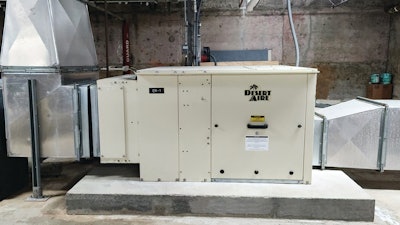 Photo courtesy of Desert Aire
Photo courtesy of Desert Aire
In the air
For decades, locker room signage asking pool users to shower before entering the water have proven all but worthless. Yet those signs carried the best of intentions.
“We can certainly try to convince [everyone] to shower before they get in the pool and get all the nasty stuff off their body, because that way there wouldn’t be as much chlorine having to treat the stuff that comes off of each person in the pool,” Stewart says. “But everybody thinks, ‘Why do I need to take a shower? I’m going to the pool.’ ”
“One person not taking a shower can affect the pool for nine days,” Mick Nelson, then the club facilities director for USA Swimming, told Swimming World after future U.S. Olympian gold medalist Caleb Dressel was hospitalized in the middle of the 2013 USA Swimming Winter Junior National Championships at the Greensboro Aquatic Center in North Carolina. Officials blamed poor indoor air quality at the facility, which has since been upgraded and is now considered one of the premier natatoriums in the country.
The old-school way of treating airborne chloramines was “solution by dilution,” Hines says. “Just keep increasing the amount of outdoor air that you bring into the facility, and it’ll dilute the indoor air and take care of everything. The truth is, it can’t do that — because the air still gets recirculated, unless you remove 100 percent of the air and put in 100 percent fresh air all the time. And even if you do that, the cost is astronomical.”
Plus, chloramines still travel through and eat away at mechanical systems, shortening their lifespans.
 photo courtesy of Paddock
photo courtesy of Paddock
Since its introduction more than a decade ago, the Evacuator’s cost has dropped to encourage more facilities to install the product, Hines says, adding that about 400 units are now in use across the country.
Desert Aire distributes the Evacuator bench system and manufactures the RecoverAire™ system, which works with the Evacuator bench (as well as gutter venting and deck venting systems) to remove chloramines and recover energy from the exhaust air to heat pool water.
“It’s the exhaust fan for sucking the air through the bench, recovering the energy from that exhaust air stream and moving it back to the pool,” Stewart says. “We look at how much air you need to move out of the exhaust … to be replaced by fresh air.”
A major key to ensuring safer indoor air quality in new facilities going forward, according to Hines, is to convey its importance (and intricacies) to architects, aquatic designers and local officials and leaders — such as school boards and city councils.
“My comment to architects, specifically, is, ‘Nobody knows when they walk into a beautiful new facility who the aquatic designer was or who the equipment supplier was. But they often know who designed the pool,’ ” Hines says, adding that Paddock offers “lunch and learn” sessions for architecture firms about the Evacuator. Those events also include tours of facilities that use the system as well as those that don’t, allowing architects to feel for themselves the differences in indoor air quality.
Unless a pool chemical is developed that can accomplish everything chlorine does but without the off-gassing, indoor air quality will always be an issue for pool operators. In the meantime, operators are encouraged to pay attention to user complaints about persistent coughing and irritation to eyes or skin. Likewise, metal fixtures and fittings that appear to be prematurely corroding could indicate an indoor air quality problem that should be addressed.
Keep this in mind, too: The busier a pool is, the greater the odds of it exhibiting poor indoor air quality.

In the water
While indoor air quality impacts everyone inside a pool facility, pool water quality affects people in the pool — those who represent the primary reason the pool exists in the first place.
“There is more known today about water quality and factors that lead to maintaining proper water quality than at probably any other time in the history of swimming pools,” Walsh says. “But at the same time, it’s a very complex science. In many cases, pool operators — and there’s another ambiguous term, because pool operators can range from degreed individuals who have a complete understanding of chemistry to someone who just got handed the job because he was available — are not the problem. They can only do what they are allowed to do within the funding limits they have.”
“A younger generation of pool operators is emerging and, in general, they are much more comfortable with technology and automation than the previous generation,” Steinbrueck adds, noting there are plenty of industry-wide and company-specific training and education opportunities available for pool operators. “However, they have less experience with water chemistry than those they’re taking over for. Many experienced operators have maintained water quality by hand at one point or another in their careers, and consequently understand the subtleties that go along with that.”
Walsh suggests that organizations developing a new indoor aquatics facility hire a certified pool operator early on and make that person part of the planning and design process.
“Think about it: You’re building a water space that will cost several million dollars; what amount are you allocating to understanding how you’re going to operate it?” he says. “The pool operator understands the equipment that’s available today and the cost-benefit aspects of it. They need to be as involved as possible as to what kind of equipment is being used in the construction or renovation of a facility. Unfortunately, oftentimes there’s no consensus between the operators, the specifiers and the contractors as to what’s right. And oftentimes it’s the pool operator who may be the most informed — even though they might be the last person hired. That’s kind of a tragedy.”
Walsh also recommends bringing in a representative of the local chemical supplier that likely will be contracted to deliver product to the new facility; after all, he reasons, it makes no sense to design a treatment system if the chemicals to keep the pool operating clear and smoothly aren’t available at the desired price.
Natare manufactures the MicroFlo® vacuum sand filter. According to the company, its “uniquely designed flow-diversion screen and simplified operating controls take the guesswork out of high-volume water filtration, allowing easy access and a visual check during the filtration process.”
“It’s a filtration plant that does everything from minimizing the amount of water used and energy consumed to removing some of the smallest particulate matter of any filter on the market,” Walsh says, noting that it’s also the most expensive filter on the market but typically pays for itself within two to four years.
Meanwhile, BECS Technology offers several BECSys controllers, including BECSys Live — an online portal providing access to BECSys controllers from any PC or smartphone to allow real-time monitoring of water conditions. Users also can change settings, view historical graphs and run reports. When a controller goes into alarm mode, typically because a reading is outside an acceptable range, the controller can send an email or text message notification to programmed users, according to Steinbrueck.
“This allows operators and maintenance staff to immediately respond to problems while the situation is still reasonably manageable — much better than discovering a problem hours later on the next visit to the equipment room,” he says. “These are very powerful tools that really help today’s busy staff manage their time more effectively and also improve water quality, and they’re included with BECSys controllers.”
Steinbrueck also is noticing a trend toward increased automation, in large part because he says controllers do a better job maintaining water chemistry than manually hand-dosing chemicals. The chemistry controller continuously monitors water conditions and can feed chemicals as needed based on changes in demand. Other functions being automated into aquatics controllers, he adds, include alkalinity control, autofill, variable frequency drive control and filtration/backwash control.
As technology evolves and one generation of pool operators transitions to the next, it will remain imperative for facilities to maintain high air and water quality standards. Doing so will help establish competitive and recreational facilities as go-to destinations — ones where patrons both in and out of the pool can have comfortable and memorable experiences.
Says Stewart, “The people who can make a difference are the owners and operators who realize there is a solution.”




















